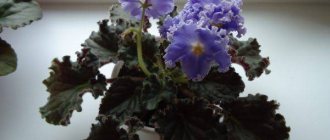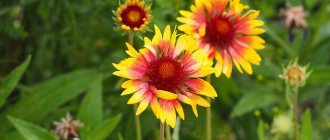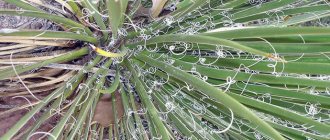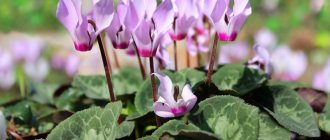- March 25, 2019
- Flowers
- Natalia Egorenkova
Summer residents come to their gardens in April and see primrose, which has hospitably opened its doors to spring with its charming key flowers. Due to its early flowering, this plant is called a primrose; its decorative value is highly valued and entire collections are bred, striking in the variety of inflorescences. There is nothing complicated in planting and caring for perennial primrose, and if you follow the basic rules of agricultural technology, the blooming beauty will greet you at your dacha every spring.
What kind of flower is primrose?
Don’t be surprised that every garden has primroses, even the simplest ones. This is exclusively our plant, which grows in temperate latitudes of the Northern Hemisphere, and is extremely rare in other climatic zones.
Primrose belongs to the Primula or Primrose family. Its closest relatives are the common loosestrife and the common loosestrife, the European seven-footed grass and the seaside milkweed. All these flowering herbs often decorate our flower beds, but few people know their biological names.
The genus Primrose includes about 400 species of mostly perennial herbs, known since ancient times, extremely popular and widely cultivated in many European countries.
The name of the plant comes from the Latin word primus, which means “first”, because the primrose blooms very early, when in some places there is still snow.
A novice gardener should definitely take up perennial primrose. Planting and care will not burden you, it blooms for a long time, and dense rosettes of decorative leaves will decorate the flower beds until frost.
History of appearance
Indoor mint: home care and methods of propagation
It is not known exactly when primrose appeared; even in ancient times, people knew about its medicinal properties. There are several legends about the origin of the flower. One of them says that the Apostle Peter was the keeper of the keys to Paradise, and one day he learned that evil spirits had forged his keys. Peter got scared and, through his carelessness, dropped the bunch on the ground; later a flower grew in this place, which reminded him of this incident. The primrose inflorescence turned upside down looks like a bunch of keys. Translated from German, the name of the flower sounds like “Peter’s Keys” or “Heavenly Keys”.
Yellow inflorescence
What does primrose look like?
Any primrose is a low and compact plant. Together with the peduncle, its height is only 25 - 50 cm.
Despite its modest size, primrose has a highly developed fibrous root system, so the plant takes root well, and damaged ones are quickly restored.
Primrose leaves form a dense rosette. They are oval or lanceolate in shape, light green in color, sometimes with a grayish tint. The surface of the leaf is usually wrinkled, as if corrugated, strewn with barely noticeable fibers; the edges can be smooth or cut with small teeth.
The stem of the primrose, also known as the peduncle, is always bare, in many species it is long, sometimes erect or directed to the side. If proper attention was paid to planting and care when growing perennial primrose, the plant will delight you with many flower shoots.
How to propagate at home
Indoor primrose propagates in two ways: using seeds or dividing the bush. The algorithms for each option are described in detail below.
To grow a new primrose using seed, follow these instructions:
- Every year, at the end of the summer season, visible boxes containing seeds ripen on the indoor primrose. They must be carefully collected and planted immediately.
- You will need several glasses or small pots with fresh substrate for primrose or geranium. For planting, prepare no more than 3 seeds in each container. Lightly press the flower seeds into the soil.
- Cover the pot or glass with cling film so that excess air does not enter and the greenhouse effect is maintained.
- Open the film once a day to ventilate the soil. After about 20 days, the first shoots should appear and need to be moved to a dark place. The temperature regime for the successful growth of a new plant is 13-15 degrees.
- As a rule, only one seed out of three germinates - the healthiest and strongest. However, it is possible that all three will begin to sprout. In this case, select the two weakest sprouts and carefully cut them off at the base.
- After 1.5-2 months, the seedling should get stronger. Only then can it be transplanted into a separate permanent pot, where it will continue to be cared for in the same way as an adult plant.
If you decide to divide the bush and thereby propagate the flower, then follow this algorithm:
- The procedure must be carried out in March. Transplanting and dividing primrose is not as difficult as it seems at first glance. It must first be removed along with the root system from the pot. To help the soil settle better, the plant can be watered with a small amount of water.
- Next, carefully divide the primrose into 2-3 bushes, so that 3-4 growth buds remain in each separated area. It is recommended to sprinkle the sections with charcoal, crushed in advance.
- Plant each bush in a separate pot with fresh soil.
- After 10 days, the sprout can be watered and a little fertilizer added. Further care for primroses is no different from maintaining an adult plant.
Rich palette of primroses
Primrose flowers consist of five petals, collected in inflorescences of various shapes: a brush, an umbrella and even a ball. One of the features of the plant is a very long flower tube formed by petals fused at the base. Therefore, do not be surprised if you rarely see bees and bumblebees on key flowers. It can be difficult for honey insects to get to the nectar.
The primrose fruit is an elongated seed capsule. However, most gardeners cut off the faded stems without waiting for the seeds to ripen, and prefer to propagate the primrose by dividing the bush.
Today, based on species diversity, many varieties of primroses with double and simple flowers, single and collected in fancy inflorescences, have been bred. Gardeners are more familiar with lilac and yellow flowers, but there are red, pink, burgundy, purple, black and snow-white primroses.
Do you know why experienced gardeners recommend growing perennial primrose? Even a novice gardener can easily cope with planting and caring in open ground.
Types and varieties
Now there are more than 500 species and varieties in this genus. At the time of purchase, it is necessary to find out the name, since later it will be possible to determine the features of care. The main differences relate to how many years the plant can grow, how much sunny place it needs to grow, and how long and vigorously the flowering will take place.
The most popular types of primrose:
- Stemless (ordinary) - grows mainly on alpine slopes in close proximity to melting snow cover. Quite large leaves are partially preserved throughout the winter. Peduncles with single buds can grow to a height of 6-20 cm. The petals are light yellow or white with a purple center. The first buds open in March, sometimes re-blooming occurs in early autumn.
- High – found naturally in the Carpathians and Western Europe. The veins on the leaf blades are depressed on top and convex on the underside of the leaf, which makes them especially attractive. A characteristic feature is the presence of a jagged edge along the edge. Up to 15 buds develop on the peduncles, from which flowers appear 2 cm in diameter, pale yellow in color. The peduncle is tall - up to 35 cm, flowering continues from early April to May or early June in the absence of heat. A large number of large-flowered hybrids have been bred based on this variety.
- Siebold is a species that blooms in summer, so it is often used for plantings with a continuous flowering cycle. The peak of decorativeness occurs in June. Flowers can be all shades of pink and lilac. Umbrella inflorescences form on the peduncles. After the flower stalks dry out, all above-ground vegetative parts of the plant die off until next spring.
- Spring (medicinal) - found mainly in Europe. A medium-sized bush with characteristic leaf blades on which the relief of the veins is pronounced. The petals are colored yellow, and the middle is usually orange. Peduncles appear from April to June. In representatives of this species in the wild, the most common mutation is in the form of terry, so a huge number of terry hybrids have been created on its basis.
Stemless (common)
Siebold
Spring (medicinal)
Primrose high
How to grow primrose from seeds?
It’s good when neighbors plant their plants and carry ready-made bushes with gorgeous roots to each other on a shovel. But if there is nothing to plant yet, they can give you dry seed pods. And sometimes you come across seeds of very beautiful primroses in the store, and the question arises: when is the best time to plant them?
There are 2 ways to sow primrose seeds: in open ground before winter and in spring in a nursery. Planting material in factory packages will last until spring, but it is better to plant your own seeds in the fall, because they are poorly stored and quickly lose their viability.
Winter storage and replanting
If you become the happy owner of an indoor primrose during the snowy season, then in order to preserve it, you will definitely need to replant the primrose - it will not live long in a store-bought substrate of peat and a small amount of fertilizer.
The procedure should be carried out one day after purchasing the green beauty.
- Choose a convenient pot, add drainage to the bottom, prepare a universal substrate and a small amount of river sand.
- Carefully remove the plant itself from the old container, being careful not to damage the rhizome.
- Mix the soil with river sand and sprinkle the drainage mixture a little.
- Next, hold the rosette of the plant with one hand, and with the other, carefully pour the substrate to the edges of the pot.
- Pour the primrose generously with soft, settled water. Now it will be able to bloom and delight its owners all winter.
If the primrose transplant was done in advance, then make sure that it stands in a warm room in winter, avoiding drafts. Low temperatures are detrimental to indoor culture, so it is recommended to choose a place on the windowsill, not too close to the radiator, where diffuse sunlight will fall.
Sowing before winter
It is important that the seeds do not germinate, so the optimal time for winter sowing is cold weather before the onset of stable frosts: October and early November. There is no point in looking for a place in flower beds; no one guarantees 100% germination, and young plants will have to be replanted in any case.
For the “kindergarten” they choose a place in the garden bed where nothing is planned to be planted in early spring. The main thing is that the soil is loose and fertile, on which a soil crust does not form.
The grooves are made in advance; the bottom can be sprinkled with a thin layer of sand so that in the spring the melting snow does not wash the seeds into the lower layers of the soil. They sow often and shallowly, 1 - 1.5 cm, because there is no guarantee of 100% germination, and in nature primrose seeds are carried by the wind and no one sprinkles them. There is also no need to make shelters; garden primrose is one of the most frost-resistant crops, so the seeds overwinter well and quickly begin to grow in the spring.
However, in regions where temperatures often drop below -20 °C, it makes sense to postpone sowing seeds until spring.
general description
Primula vulgaris is a genus with a huge number of forms and hybrids. Every year, breeders develop new varieties with fancy colors and improved characteristics that can make caring for this crop easier.
In the wild, the genus has a wide distribution: it is found in Africa, Europe, the Middle East, South America, the Himalayas, etc. For normal development, the plant chooses places with high humidity - the banks of rivers, streams, meadows, where it lingers for a long time in the spring moisture.
A small rhizome develops underground, from which a root rosette is formed at soil level. It consists of oblong or oval leaf plates that can completely cover the ground. Sometimes the leaves are raised above the ground on oblong petioles.
In different forms, the peduncles can be tall or squat, single or with a large number of buds. As a rule, the more buds on the peduncle, the smaller the diameter of each opened flower. In nature, the flower shape is always simple, double is a mutation, but breeding varieties can be simple, semi-double and double.
After flowering, a spherical achene is formed. In hybrids, from seeds in the next generation bushes grow that do not have all the decorative properties of the mother flower, so seed propagation is not suitable for them.
The genus includes perennial and annual forms. It is important to know this point when purchasing a new copy.
Sowing seedlings
Until March, your planting material is stored in the same way as marigold, calendula or petunia seeds: well dried, in an airtight container.
Please note: even seed manufacturers recommend mandatory stratification when sowing perennial primrose, i.e., creating conditions as close as possible to wintering in open ground. To do this, the seeds are sown in a seedling box filled with well-moistened fertile soil and lightly sprinkled. Cover the container with glass or a bag and place it on a shelf in the refrigerator. At a temperature of + 5 ... + 7 ° C, 7 - 10 days are enough, after which the box can be moved to the windowsill and the glass removed. Such manipulations significantly improve seed germination.
At a temperature of + 18 ... + 20 ° C and constantly moist soil, primrose sprouts appear on days 10 - 14. Primrose does not like direct sunlight, so in clear weather the box is removed from the windowsill or shaded. When the first true leaf is fully formed, the seedlings are planted in pots or cups with a capacity of 200 ml or several pieces in larger containers.
Young, poorly rooted plants may not tolerate sub-zero temperatures. Therefore, it is better to postpone planting perennial primrose until there is a risk of return frosts, and in the meantime think about where the primrose will look especially impressive.
Feeding
It is not for nothing that primrose is called a primrose, because it resumes growth in early spring and immediately after the snow melts it needs feeding . It is necessary to add a complex mineral fertilizer containing nitrogen, phosphorus, and potassium to the soil under the overwintered plant at the rate of 10-20 g per 1 sq.m. Often, last year’s foliage interferes with fertilizing, so before applying fertilizer, dried primrose leaves must be removed and the soil loosened, thereby creating air access to the roots.
To stimulate flowering, 2 weeks after the first feeding, add a second one : superphosphate in a dose of 10-20 g per 1 sq.m. 12-15 days after the start of flowering, the primrose is fed with a solution of mullein; for this, 1 part of this organic fertilizer is diluted in 10 parts of water and half a liter is applied per plant. This feeding stimulates the formation of next year's flower buds.
Fertilizing with phosphorus and potassium fertilizers in mid-August ; this can be a solution of mineral fertilizers (15-20 g per 10 liters of water).
Best place to land
It’s not for nothing that summer residents love primrose, and experienced gardeners recommend it as a universal crop that has a place in the implementation of any landscape design options. It may bloom for only 30-40 days, but when planted correctly it brings incredible aesthetic pleasure, and its corrugated leaves turn cheerfully green until the first snow.
Primrose grows best in partial shade. It is also planted in open areas, but does not bloom so brightly. Let's look at the most interesting ideas for planting primrose:
- design of the banks of ponds and artificial reservoirs;
- northeastern slopes of alpine hills;
- border planting along garden paths;
- tiered flower beds and mixborders;
- flower beds with other low-growing flowers (daisies, snapdragons, lobelia, ageratum, etc.);
- growing in pots to decorate balconies, verandas, terraces and gazebos;
- as a houseplant for year-round cultivation (special varieties).
It is noteworthy that the primrose not only perfectly coexists with any compact flowers, but also protects them from weeds. Anyone who has planted primrose knows: next to it there are practically no even the ubiquitous dandelions and primrose. However, she may overdo it and begin to crowd out her long-term neighbors from the flowerbed. Therefore, it doesn’t hurt to know the specifics of planting and caring for perennial primrose.
Photos of examples of landscape design with perennial garden primrose
Primrose: a photo of flowers in a flowerbed can be seen below:
Photo of primrose in garden landscape design:
How to plant correctly?
Primrose can grow on heavy, moderately acidic soils, but it will not please you with its high decorative value. The soil should be loose and fertile, but do not overuse organic matter, otherwise the primrose will grow greatly to the detriment of flowering. Before planting, it is enough to add 2 buckets of compost per 1 m2 of land and dig it well.
If the primrose is planted separately, at least 30 cm is left from the bush to the neighboring plants. When planting in rows, there should be 20 cm of space between the seedlings; this is enough to form strong rosettes and close the plants together.
The primrose takes root well, sometimes sheds its lower leaves, but quickly makes up for what it has lost.
Transplanting a plant
Indoor primrose is sold in small containers; it needs to be replanted immediately after purchase. Also, adult plants older than 3-4 years are transplanted to a new location.
To transplant primrose, it is important to choose the right pot; its volume should be 2-3 times larger than the upper part of the plant with leaves. There should be holes at the bottom of the pot to allow excess water to escape. You can purchase ready-made soil for primrose or make it yourself by mixing sand, peat and deciduous soil in equal proportions.
How to replant:
- Carefully dig up the plant. If the roots are intertwined, there is no need to untangle them, just shake off the excess soil. Primroses have thin and fragile roots that break easily;
- Drainage is laid at the bottom of the pot, the thickness of the layer is from 1 to 3 cm, depending on the size of the pot;
- It is necessary to fill 3-4 cm of prepared soil on top of the drainage layer and compact it with your hands so that the roots of the plant do not touch the drainage;
- The plant must be placed in a pot and covered with soil on the sides. There is no need to compact the soil;
- The flower needs to be watered with settled water. The soil may become compacted and settle, in which case you need to add more soil mixture.
Primrose root system
Note! It is not recommended to replant the primrose immediately after purchase, since changing the location and soil is stressful for the plant. The flower must spend several days in a new location, only then can it be transplanted.
Basic agrotechnical measures
When growing perennial primrose, its decorativeness and flowering largely depend on planting and care, although some species do not throw out flower stalks at all in the first year.
In order for primrose to thrive in your garden, you should remember and adhere to the basic rules of agricultural technology:
- if there is not enough natural moisture, water during drought, preventing the soil from drying out;
- lower yellowed and dry leaves are promptly removed;
- in plants older than 2 years, the root collar is often exposed, so you need to add soil as necessary;
- In the first year, many gardeners do not feed their primroses at all. Starting from the 2nd year, it is recommended to feed 2 times: before flowering directly in the snow and in the fall; In the spring, dry superphosphate granules are used, at the end of the season - an ash solution;
- There is no need to cover the primrose for the winter.
Agree, growing primroses will not take much time. Planting and care in open ground are simple and easy, but you should not allow the bushes to grow too much, otherwise the plant will begin to degenerate and stop blooming.
Bloom
When and how does it bloom
It is generally accepted that primroses bloom only in early spring. Primrose is a plant whose flowering time depends on the variety. Some species bloom from April to June, while others bloom at the beginning of summer.
When does hydrangea bloom - flowering period, how long does it bloom
Despite the relatively small size of the plant, large and bright flowers grow on it. Often, the inflorescences are umbrella-shaped and grow on a flowering stem 25 to 50 cm high. Depending on the variety, 1 flower or a group of several buds grows on the stem.
The color range is wide, including shades of purple, red, flowers can be white, yellow or pink. The petals can be plain or variegated in 2 or 3 colors at once.
Perennial varieties that bloom every year are very popular. Lovers of house plants know how long perennial primrose blooms, and appreciate it for this. With proper maintenance, the flowering period can last throughout winter and spring.
Flowering period
One of the best indoor flowers that quickly takes root at home is the primrose. How long does this plant bloom? On average, the flowering period lasts 1-3 months; during the year, different types of primrose bloom several times.
If the indoor primrose has faded, what to do next:
- Remove dry and yellow leaves and inflorescences;
- Reduce watering to 1-2 times a week with small portions of water. There is no need to spray with water from a spray bottle;
- Leave the plant in a cool, well-lit room.
Why doesn't it bloom
Primroses look great when they bloom, which is why they are bought. Sometimes primrose owners are faced with the problem of a lack of flowers on the plant, the reasons for this may be different:
- Increased indoor air temperature. Primroses do not tolerate temperatures above 19-20°C; they will grow, but without flowers;
- Low humidity in the room, in this case the flower begins to dry out, it does not have enough strength to bloom. Also, do not expose primrose to direct sunlight;
- Strong drafts. Indoor plants are less resistant to temperature changes;
- Lack of sunlight. This usually happens if the pot is near a north window;
- During the heating season, a flower pot stands on the windowsill above the radiator;
- Lack of space in the pot. Over time, the flower grows, it needs to be replanted - it may not have enough previous volumes of land. The new pot should be 2-3 times larger than the top of the plant;
- No fertilizers. If the soil has not had time to be fertilized, the primrose may not have enough nutrients to form inflorescences;
- Too frequent watering, using untreated tap water;
- Incorrect soil composition and soil salinization;
- Lack of drainage layer at the bottom of the pot, water stagnation;
- The plant is affected by diseases or pests. You can recognize the problem by the color of the leaves; they change color or become stained;
- Too early to bloom. Perhaps there is a primrose growing at home, the flowering season of which begins later.
The presence of at least 1 problem can slow down the flowering period. If all the causes are eliminated, the plant will bloom again next season.
Note! Flower shops often sell annual plants; this needs to be clarified when purchasing. If the primrose is annual, there will be no re-blooming.
How to plant primrose correctly?
Usually 3-4 year old primroses are planted and this is done after flowering. You can try to divide the dug up bush with your hands: if the ground is well moistened, the plant easily breaks up into separate rosettes. If this does not work, the bush is cut into several parts with a sharp knife, after which it is transplanted to new places or given to neighbors.
By the way, you can dig up and divide perennial primrose during flowering, when there is interest, for example, to sell beautifully flowering varieties and species.
As practice shows, when growing perennial primrose, planting and care does not cause gardeners any trouble and plants rarely get sick. However, it doesn’t hurt to know about the misfortunes that affect primroses, especially when growing rare varieties.
Primrose in the house: beneficial properties
The plant has been known since ancient times for its healing qualities. It contains many vitamins and carotene. The roots contain glycosides and essential oils. The leaves contain a lot of ascorbic acid. Therefore, in spring it is useful to eat salads with primrose as a source of vitamins.
Decoctions and infusions of the plant are effective for diseases of the respiratory system:
- laryngitis;
- bronchitis;
- tonsillitis.
Primrose decoction will help normalize sleep and stabilize the nervous system. But allergy sufferers should take primrose products with great caution. There are species that are strong allergens.
Indoor primrose is a spring primrose that can decorate any interior. Unlike garden species, it is more whimsical. But caring for the crop is not difficult; it reproduces easily and takes root when suitable conditions are created.
How to grow indoor Primrose and how to grow the plant at home? More useful tips for flower growers can be found in the following video:
Diseases and pests
It’s a pity to lose flowers, and it doesn’t matter whether they are varietal primroses or the most common types. Among the lesser evils, it is worth noting common pests: snails and aphids, which appear in damp weather on heavily thickened plantings. The barrier for the former is the granular drug “Thunderstorm”.
You can clean garden primrose from aphids with a soap solution of any dishwashing detergent, and large colonies of insects can be destroyed with insecticidal preparations, for example, Iskra or Biotlin. At the same time, fight garden ants: if they leave, the aphids will disappear.
Powdery mildew can be a more serious problem. The fungal disease first affects the lower leaves, then the entire plant: first a white coating forms, and a little later drops of liquid appear - a product of the maturation of fungal spores. In the early stages, treatment with Fitosporin and Topaz helps; severely affected bushes are dug up and burned.
We hope that information about perennial primrose: planting and care, photos and recommendations will help you grow beautiful, healthy plants that will delight you with marvelous flowering for many years.
Types of primrose for home breeding
A variety of varieties of primroses are divided into garden and indoor ones. Although the first ones can be grown as domestic ones.
The following varieties are popular for keeping on the windowsill:
| Variety | Description | Leaves | Flowers Inflorescence The period of their blooming |
| Obkonika (Reverse conical) | Height - 20 cm. May cause allergies when touching parts of the plant. | Elliptical with a serrated sinuous edge. | Lavender, blue, red, salmon, purple, pink (7 cm). They smell nice. Umbrella. Year-round (with good care). |
| Soft-leaved (malacoides) | Grows up to 30 cm. | Elongated light green, indented along the edge, heart-shaped base. | White, purple, blue, scarlet, pink, two-color terry (4 cm). Paniculate. February-March, lasts 3-5 months. |
| Stemless | Does not exceed 20 cm. | Long emerald, with a bright vein in the middle. The surface is wrinkled. | Pale yellow, but there may be other shades, single (2-4 cm). April - July. |











